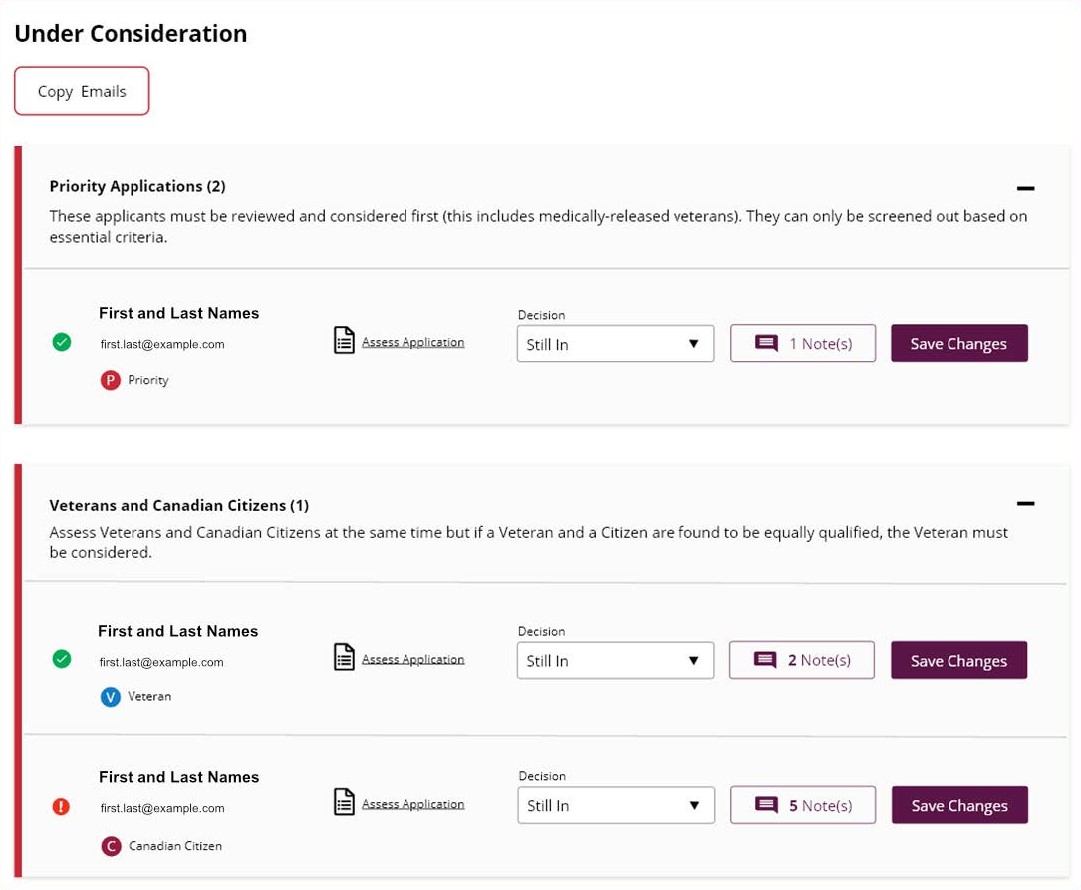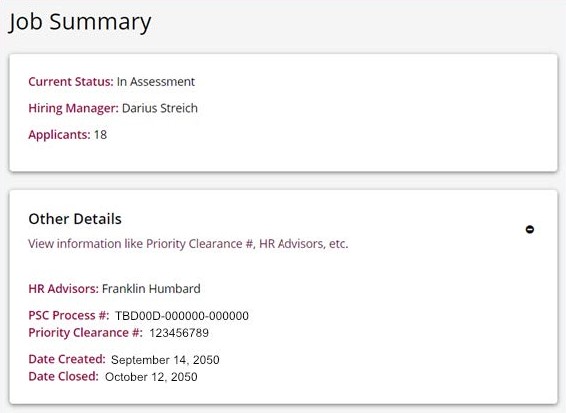In speaking with employees with priority status, many of them reported being seen as a barrier by managers in staffing processes, and managers tended to discount the talent and qualifications they had to offer. Having to continually put their names forward also became a burden. In general, participating in staffing processes as a person with priority status was an emotionally damaging experience.
Managers also reported that the priority screening process “took a long time” and held up staffing - an assertion we were keen to test for ourselves. Based on workshops with managers and HR advisors, we found that the priority clearance process was usually initiated prior to the job opportunity being advertised. As managers were advised to wait for at least five business days in case any person with priority status came forward, the process usually resulted in one to two weeks of waiting time before the manager could see any progress on their staffing process. As priority clearance expires after six months, staffing processes that took a longer period require a new clearance before the Letter of Offer can be issued. These factors have contributed to managers perceiving the priority process as an obstruction to hiring the candidate they have selected.
With the help of experts in the Public Service Commission, we mapped out a typical priority clearance process to identify areas for experimentation. We also obtained permission to request priority clearance on behalf of our partner departments in order to integrate it with the Talent Cloud process.
The test was to attempt to submit the priority request at the same time as the job opportunity is advertised, so no extra time would be added to the staffing process. Under this approach, when a person with priority status expresses interest in a job opportunity, they were asked to apply on the Talent Cloud platform instead of sharing their resume and cover letter directly with the manager. Their qualifications were then displayed in the same way as other applicants, and managers were informed that their applications would need to be assessed first.
Talent Cloud then monitored the impact of these changes on both the time to staff and on qualitative data from those with priority clearance about the experiential side of these changes.
Persons with priority status were registered in the Public Service Commission’s database, accessed through a separate system from Talent Cloud. No API was available from the Public Service Commission to connect the system to Talent Cloud, so manual data entry into the Public Service Commission’s site by Talent Cloud staff was required. (While this allowed for the test of the overall model, at larger scale, there would need to be some automation between systems for the sake of efficiency and effort involved.)
Tag persons with priority status: When a person with priority status applied on the Talent Cloud platform, we located their application on Talent Cloud, and used our platform administration portal to tag them as a priority.
Autosort candidates by priority: When managers reviewed their applicants, those who had been tagged as a priority appeared at the top of the list automatically. Managers were reminded of the legislative requirement to assess these applicants first ahead of all others.

Make it easy for HR Advisors: All priority clearance numbers were included as information on Talent Cloud’s HR advisor portal, allowing for a swift policy compliance check before HR advisors completed the final paperwork for a job process.

The PSC informed us during our initial mapping exercise that only a fraction of persons with priority status would be interested in term positions. Our results were consistent with that observation. As all job opportunities advertised on Talent Cloud are term positions, only a few persons with priority status expressed interest in those opportunities.
Amongst those individuals, their applications on the Talent Cloud portal were assessed by managers ahead of all other candidates. Managers were impressed by the qualifications of these individuals and didn’t display any negative sentiment regarding the requirement to assess these individuals first.
Because the priority clearance process occurred while the job was advertised, it didn’t add to time-to-staff. All information on clearances was easily accessible, making it simple for managers and HR advisors to complete all requirements related to this part of a job process.
No applicants with a priority entitlement identified interest in a process later than the initial application stage, but if there had been an expression of interest at a later stage Talent Cloud would have been able to integrate the applicant’s information into the process for manager consideration. That person would then have been assessed immediately.
The requirement to work with a separate system and to enter data manually has limited the scope of the experiment. That being the case, our small sample experiment suggested that interventions can be implemented to create a more holistic experience for persons with priority status, as well as reducing time-to-staff.